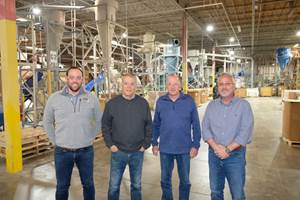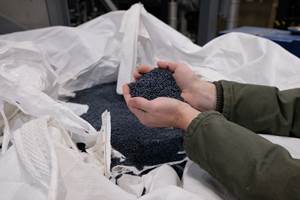Sustainable Resource Management of Plastic Feedstocks
How Encina sees its future in the circular economy.
Encina makes feedstock monomers from end-of-life plastics. In April, the company made news with a big investment to build its first commercial scale facility in Pennsylvania. Recently I spoke with Sheida Sahandy, Chief Sustainability Officer and General Counsel at Encina, about her vision for the circular plastic industry.
Encina’s process begins with sorted, post-consumer waste from MRFs, along with high-value scrap material. A second sort is performed, removing contaminants and redirecting fractions that can be mechanically processed to other recyclers. The catalytic transformation process is capable of recycling a range of resins in the future, but right now the company is focusing on PE, PP, and PS. Using pyrolysis with a catalyst, the sorted material is broken down into aromatic hydrocarbons: benzene, toluene, and xylene. The products are virgin-quality and are purchased by resin producers to create polymer with recycled content.

Structural depiction of aromatic compounds produced by Encina. From left: benzene, toluene (methylbenzene), and xylene (dimethylbenzene). Xylene has three isomers, the para positioning is shown.
Image Credit: Adapted from PubChem CID# 241, 1140, & 7809.
According to Sahandy, the benefits extend beyond keeping end of life products out of the landfill system. An immediate benefit is the smaller carbon footprint of plastic production from the recycled feedstock, when compared to production from petrochemicals. A longer term, policy-level benefit comes from creating a valuable end-product from something previously thought of as waste. This encourages better collection and keeps materials in the value chain.
Encina presents its process as a complement to rather than a replacement for mechanical recycling. The process can accept a wider swathe of resins and materials can pass through the process many times. Because the material is taken back to the monomer stage, the problem of degradation is ameliorated.
“I think of it as rewinding the chemical process; rewinding, reusing, and rewinding again,” said Sahandy.
Pennsylvania and Beyond
The announced Pennsylvania plant is currently in the permitting and planning stages, with a target of completion in 2024. When completed, it will have a capacity of 450,000 tons, an amount of plastic that could fill a football stadium. It’s a substantial number: the Association of Plastics Recyclers placed the total amount of plastic recycled throughout the entire US at 2.4 million tons in 2020.
But Encina has no intention of stopping there. They are looking at possible future sites in the US and internationally. Locations have not yet been determined, but Encina is looking to play a role in boosting recycling capacity in communities where it is lacking.
Catalytic pyrolysis falls under the increasingly large umbrella of “advanced recycling”, the regulation of which has been the topic of much legislative grappling in many state legislatures over the past few years. Some recycling programs have been criticized for using plastics to create fuel oil—potentially slowing the transition to a carbon-free energy system—or for simply using the plastic itself as a fuel.
Encina seems confident that regulation is becoming more refined as understanding of new technology improves and will accurately reflect what they actually do—which is not collection, incineration, or manufacturing of plastics. Unlike some of the processes in this broad category, Encina’s is aimed at providing feedstocks that are from plastics and for plastics. On September 21, American Styrenics announced an offtake agreement with Encina for the purchase of up to 250,000 tons annually. The company will incorporate Encina chemicals into its polystyrene products, in support of its goal of 30% recycled content by 2030.
Synergetic Solutions for Managing Plastic as a Resource
Sahandy doesn’t see recycling as enabling infinite expansion of production, but rather as one of many parallel solutions including reuse, plastic alternatives where appropriate, and new developments like bioplastics. She cautioned that outright bans on plastic could be very harmful to some communities, for example where municipal tap water supplies are contaminated.
“We should be selective about when and where we switch out, because in many situations there is no substitute, and the whole cycle should be managed. Our ethos is not ‘pro-plastic,’” she said. “Our ethos is ‘better resource management.’”
Related Content
Evolving Opportunities for Ambitious Plastics Recycler
St. Joseph Plastics grew from a simple grinding operation and now pursues growing markets in recycled PP, food-grade recycled materials, and customized post-industrial and post-consumer compounds.
Read MoreRecycled Material Prices Show Stability Heading into 2023
After summer's steep drop, most prices leveled off in the second half.
Read MoreNew Facility Refreshes Post-Consumer PP by Washing Out Additives, Contaminants
PureCycle prepares to scale up its novel solvent recycling approach as new facility nears completion.
Read MoreFast, Simple QC Method Directly Quantifies Recycled Content in Plastics
Novel fluorescence-based spin-out technology provides a rapid and reliable method to measure and certify recycled content in a wide range of plastics.
Read MoreRead Next
Troubleshooting Screw and Barrel Wear in Extrusion
Extruder screws and barrels will wear over time. If you are seeing a reduction in specific rate and higher discharge temperatures, wear is the likely culprit.
Read MoreLead the Conversation, Change the Conversation
Coverage of single-use plastics can be both misleading and demoralizing. Here are 10 tips for changing the perception of the plastics industry at your company and in your community.
Read MoreWhy (and What) You Need to Dry
Other than polyolefins, almost every other polymer exhibits some level of polarity and therefore can absorb a certain amount of moisture from the atmosphere. Here’s a look at some of these materials, and what needs to be done to dry them.
Read More









.png;maxWidth=300;quality=90)
















